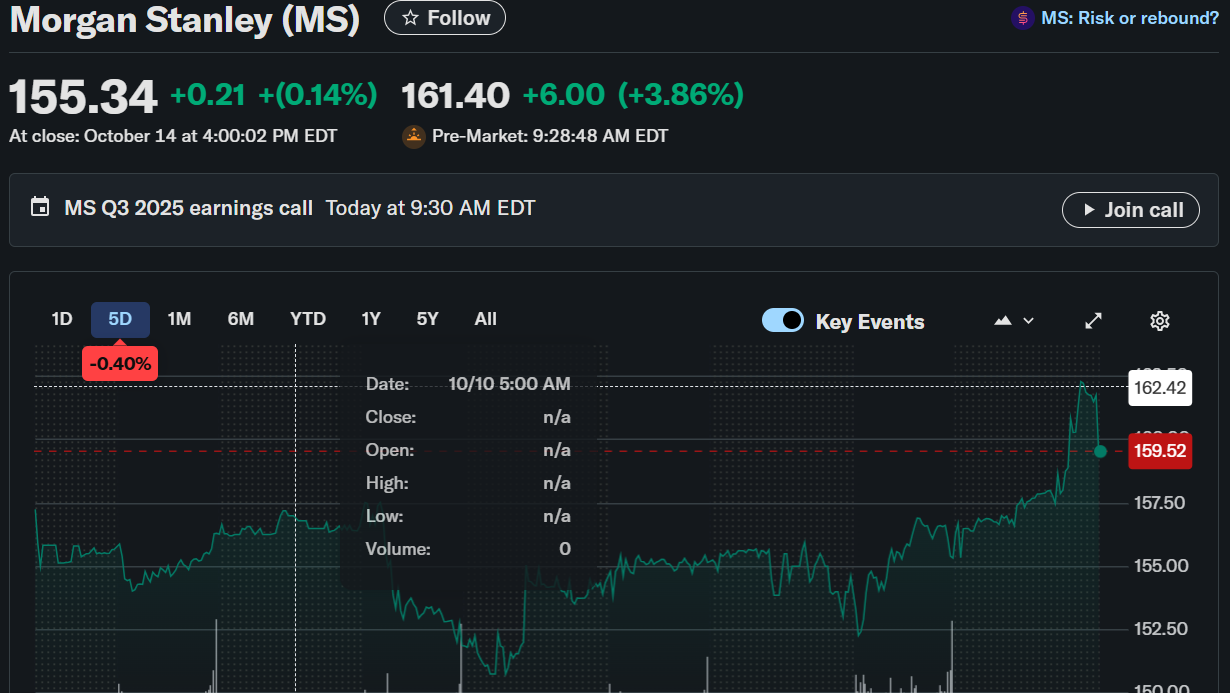Morgan Stanley (MS) Stock: Q3 Profit Surges 45% on Record Revenue and Booming Deal Activity
TLDR
- Q3 2025 profit surged 45% to $4.61 billion, or $2.80 per share, beating forecasts of $2.10.
- Revenue hit a record $18.22 billion, up 18% year-over-year and above estimates of $16.7 billion.
- Investment banking revenue jumped 44% to $2.11 billion, supported by major M&A and IPO deals.
- Equities trading revenue surged 35% to $4.12 billion, while fixed income rose 8%.
- Wealth management revenue reached a record $8.23 billion, with client assets nearing $9 trillion.
Morgan Stanley (NYSE: MS) stock closed at $155.34, up 0.14%, and traded 4.25% higher pre-market at $162.00 after reporting third-quarter 2025 earnings on October 14, 2025.

Morgan Stanley (MS)
The results marked the bank’s largest earnings beat in nearly five years, fueled by booming equities trading, surging investment banking fees, and record wealth management revenue.
Record Profit and Revenue Growth
Morgan Stanley’s profit soared 45% from a year earlier to $4.61 billion, or $2.80 per share, easily topping analyst expectations of $2.10, according to LSEG. Total revenue rose 18% to an all-time high of $18.22 billion, exceeding forecasts of $16.7 billion.
CEO Ted Pick credited the strong results to broad-based performance across the bank’s businesses. “Our integrated firm delivered an outstanding quarter with strong performance in each of our businesses globally,” Pick said in a statement.
Investment Banking Momentum
The bank’s investment banking revenue surged 44% to $2.11 billion, beating expectations by $430 million. Advisory fees climbed 25% to $684 million, driven by a resurgence in merger and acquisition (M&A) activity and new equity issuances.
Morgan Stanley advised on several major transactions, including Union Pacific’s $85 billion acquisition of Norfolk Southern, the largest announced deal globally in 2025. Equity underwriting revenue jumped 80% to $652 million as IPO and convertible bond activity accelerated. The firm was a joint bookrunner for notable IPOs, including Figma and Klarna. Fixed income underwriting revenue rose 39% to $772 million.
Wealth Management Reaches New Heights
Wealth management revenue rose 13% to a record $8.23 billion, exceeding estimates by $500 million. Rising asset valuations and higher transaction fees boosted results, while the unit achieved a 30.3% pre-tax margin, meeting its long-term target.
Morgan Stanley added $81 billion in net new assets during the quarter, with $42 billion in fee-based flows. Total client assets across wealth and investment management climbed to $8.9 trillion, nearing the firm’s goal of $10 trillion.
Market Performance and Outlook
Shares of Morgan Stanley have climbed 26.25% year-to-date and 42.48% over the past year, outperforming the S&P 500’s 13.39% gain. The stock’s three-year total return stands at 129.13%, and its five-year return has surged 260.22%, far ahead of the broader market’s 90.45%.
With optimism building around Federal Reserve rate cuts, strong corporate deal flow, and record trading levels, analysts expect the bank’s momentum to extend through the fourth quarter and into 2026.
The post Morgan Stanley (MS) Stock: Q3 Profit Surges 45% on Record Revenue and Booming Deal Activity appeared first on CoinCentral.
También te puede interesar

Silver Price Breaks Above $50, Up Over 70% Since 2025

Unlocking Massive Value: Curve Finance Revenue Sharing Proposal for CRV Holders
